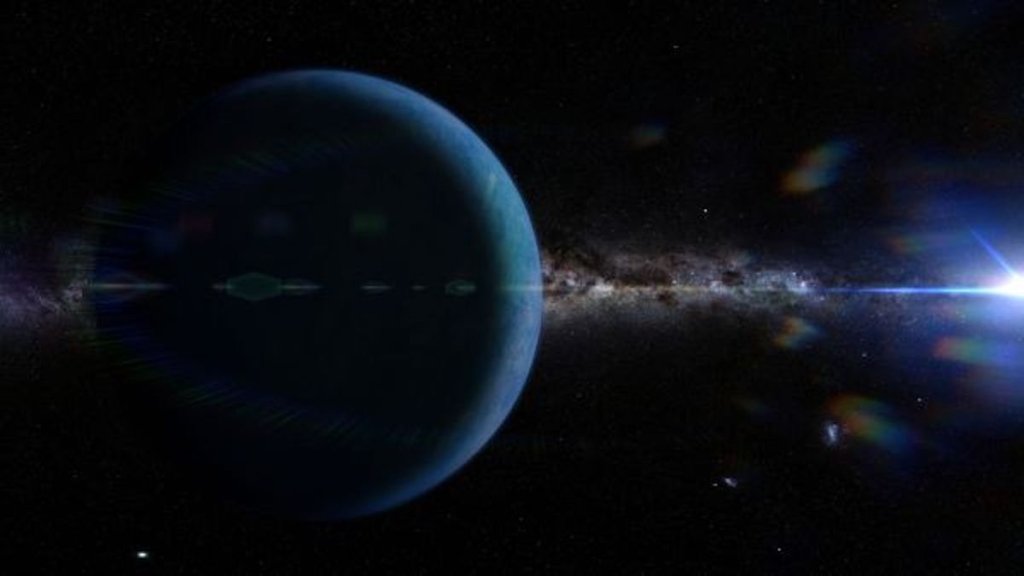As the search for “Planet Nine” in the outer solar system continues, new research suggests there may be an Earth twin buried deep within the frozen waste of the Kuiper Belt beyond Neptune.
Astronomers struggle to explain all of the properties of trans-Neptunian objects (TNOs), which are generally small, icy bodies that orbit the sun beyond the orbit of Neptune, generally with orbits greater than 30 astronomical units (AU). (One AU is the average distance between Earth and the sun: about 93 million miles, or 150 million kilometers.)
TNOs represent the leftover bits from the formation of the solar system that flung to the outer edges of the system during the chaotic early years of planetary creation. Due to the extreme difficulty of discovering and mapping such small, distant and dim objects, the known TNOs (which represent a very small sample of all of the objects orbiting at that distance) have some strange properties that currently defy coherent and consistent explanation.
For one, about 10% of all TNOs are “detached,” meaning they have no orbital relationship with Neptune. Even though Neptune is the smallest of the giant planets, it is the dominant gravitational force in the outermost solar system. For so many TNOs to lack movement controlled or influenced by Neptune is strange, as models of solar system formation generally predict that far fewer detached TNOs should remain to the present day.
Related: Could an ‘Earth-like’ planet be hiding in our solar system’s outer reaches?
Second, there is a large population of TNOs — around a few percent — that have very high orbital inclinations, meaning they orbit the sun at an angle greater than 45 degrees. Again, models of the formation of the solar system have a tough time scattering so many objects to such extremely angled orbits.
Next, there are some TNOs with very large orbits that are simply known as “extreme.” The most famous example of these is Sedna, a minor planet whose closest approach to the sun is around 76 AU and over 900 AU away at its farthest point. Extreme orbits like this require a lot of gravitational tweaking and nudging, and it’s difficult to get the gravity of the known planets to explain these extreme objects.
Lastly, some TNOs are locked into orbital resonances with Neptune, which means that for every whole number of Neptune orbits, they complete a single orbit. Some of these orbits have been stable for billions of years, despite the gravitational nudging that others in the TNO population have received.
A consistent theory of the outer solar system must be able to explain all of these discordant observations, and this is where a pair of researchers, reporting their results in a paper in The Astronomical Journal, found an interesting opportunity.
In the past, researchers have proposed that a massive planet may be lurking in the extremely distant solar system (like hundreds of AU away). However, those arguments focused mostly on the behavior of a handful of extreme TNOs. The problem is that the presence of a massive planet — something rivaling Neptune or even bigger — messes up other TNOs so much that it violates our understanding of their inclinations and their relationships to Neptune.
In the new study, the researchers ran hundreds of simulations of the formation of the solar system. The early system likely produced 10 to 100 planets with at least the mass of Earth beyond the orbit of Neptune. Most of those planets were ejected from the solar system altogether by the complex gravitational machinations of the remaining planets. But a handful may have managed to survive and may even remain to the present day.
The researchers found that a single Earth-scale planet, weighing somewhere between 1.5 and three times Earth‘s mass, may lurk in the outer solar system, living at an orbit between 250 and 500 AU. This would place the planet firmly within the Kuiper Belt, which otherwise is made up of only minor planets, like Pluto and Sedna, and uncountable smaller, icy bodies.
This hypothetical large planet, if placed on an orbit with a 45-degree tilt, could explain the known collective behavior of TNOs: how some of them are detached from Neptune while others are stuck in resonances, the large angles of some of their orbits, and the extreme nature of a small population of TNOs.
However, there is no proof of this Earth-scale planet or of any other proposed new planets in the Kuiper Belt. So far, all we have to go on is the strange orbital dance of the dim and distant TNOs. But it’s definitely an intriguing sign and one of the best ways to explain all of the available evidence.
The next steps for the researchers are to develop more detailed models so they can begin to predict where this proposed Earth-mass planet might be in its orbit and to draw up plans for an observational campaign to go hunting for it.

